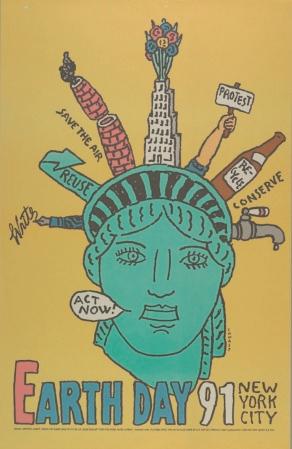
3 minute read
50 YEARS OF EARTH DAY
Fifty years ago, the first Earth Day spawned an environmental movement that led to the Clean Air, Clean Water and Endangered Species acts and the creation of the Environmental Protection Agency. Since that time, Smithsonian museums have collected myriad objects that reflect growing environmental activism and awareness, while our research centers have achieved notable successes in conservation.
To celebrate the 50th anniversary of Earth Day, the Smithsonian’s Earth Optimism Summit 2020 will showcase what’s working in conservation science. This year’s summit will be digital, bringing together thousands of people virtually for lectures with environmental leaders, a film festival, fashion show and more from April 22 to April 25.
Advertisement
For information about tuning in, visit earthoptimism.si.edu. Share your stories of success in conservation with #EarthOptimism.
1970s
The first Earth Day was held April 22, 1970. Organized by U.S. Senator Gaylord Nelson of Wisconsin, this inaugural event sparked a 50-year movement to raise environmental awareness in the United States.

6c Save Our Water single, 1970. National Postal Museum.
Copyright United States Postal Service. All rights reserved
In 1972, the National Zoo welcomed its first giant pandas, Ling-Ling and Hsing-Hsing. The pandas’ arrival launched a decades-long collaboration with Chinese scientists to better understand and save this rare and vulnerable species.

Horn Badge Company, Environmental Button, 1970. National Museum of American History

Horn Badge Company, Environmental Button, 1970. National Museum of American History

Department of Agriculture, Give a Hoot! Don’t Pollute, 1970s. National Museum of American History

10c Preserve the Environment single, 1974. National Postal Museum
The National Zoo’s Conservation and Research Center was established in 1975 on 3,100 acres at a former U.S. Army Cavalry Remount Station in Front Royal, Va., to encourage development of all aspects of animal sciences. During the 1980s and ‘90s scientists began reintroducing animals born at the National Zoo and Smithsonian Conservation Biology Institute (SCBI) to the wild. In the mid-1980s SCBI scientists developed the basis for breeding animals in human care to preserve as much genetic diversity as possible.
1980s
In 1980, ecologists at the Smithsonian Tropical Research Institute established the first forest research site on Barro Colorado Island, Panama. There, they pioneered longterm tree-census techniques replicated throughout the tropics, creating a network of tropical forest research sites known today as ForestGEO.

Horn Badge Company, Earth Day ‘80 April 22, 1980. National Museum of American History
In 1987, scientists created the Global Change Research Wetland at the Smithsonian Environmental Research Center, with experiments that fast-forward to 2100. Its first experiment doubled contemporary carbon dioxide levels in open-top chambers. Today, the wetland includes experiments on pollution, invasive species, rising temperatures and sea-level rise.

17c Rachel Carson single, 1981. National Postal Museum.
Copyright United States Postal Service. All rights reserved
During the 1980s and ‘90s scientists began reintroducing animals born at the National Zoo and Smithsonian Conservation Biology Institute (SCBI) to the wild. In the mid-1980s SCBI scientists developed the basis for breeding animals in human care to preserve as much genetic diversity as possible.

20c Smokey Bear single, 1984. National Postal Museum.
Copyright United States Postal Service. All rights reserved
1990s

Seymour Chwast, Earth Day ‘91 New York City, 1991. Gift of Steven Heller and Karri Jacobs, Cooper Hewitt, Smithsonian Design Museum

McDonald’s: Global “ReLeaf,” 1991. Cooper Hewitt, Smithsonian Design Museum.

Paul Rand, Poster, Earth Day ‘95, 1995. Gift of Marion S. Rand, Cooper Hewitt, Smithsonian Design Museum

33c Earth Day single, 1999. National Postal Museum.
Copyright United States Postal Service. All rights reserved
2000s
In 2008, the National Museum of Natural History, in partnership with the National Oceanic and Atmospheric Administration, opened the Sant Ocean Hall—the only exhibition in the nation devoted to a global view of the ocean. The hall inspires visitors to learn how to protect and manage our oceans. The Smithsonian’s National Zoo and Conservation Biology Institute (SCBI) joined the nation’s top bird science and conservation groups to publish State of the Birds 2014—the most comprehensive review of long-term trend data for U.S. birds ever conducted. The report’s strongest finding? Conservation works.

Hiroshi Sugimoto, North Atlantic Ocean, Cape Breton Island, 1996. Museum purchase with funds provided by The Glenstone Foundation, Mitchell P. Rales, Founder, 2006, Hirshhorn Museum and Sculpture Garden.
PHOTO Lee Stalsworth
In 2017, the Smithsonian hosted the inaugural Earth Optimism Summit, drawing leading scientists, researchers, artists, civic leaders and conservation-minded citizens to discuss global solutions for conservation. The summit was a zero-waste event.
In April 2018, the U.S. Green Building Council’s Leadership in Energy and Environmental Design (LEED) program awarded Gold certification to the National Museum of African American History and Culture—the first museum on the National Mall to receive this honor.





